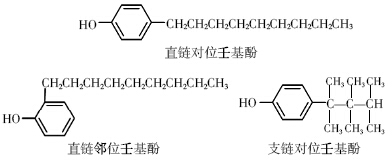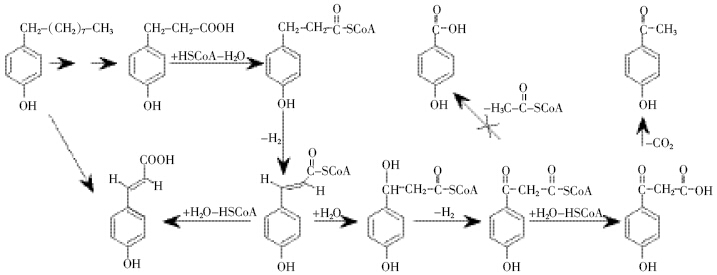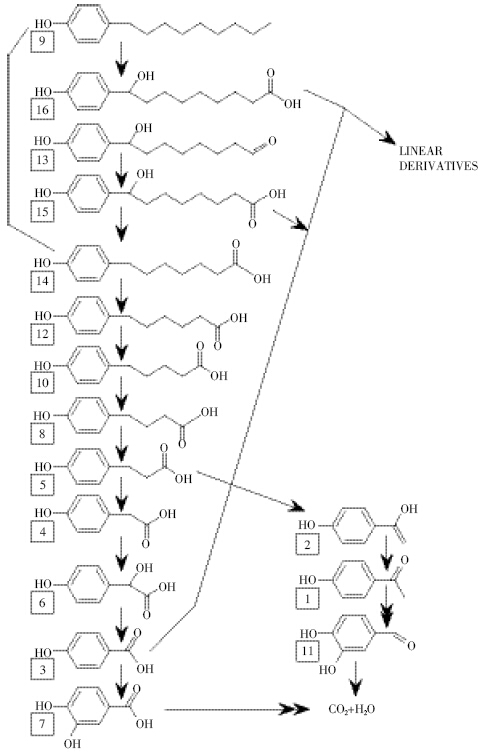文章信息
- 张婷瑜, 张福金, 何江, 孙惠民, 姚一萍, 吕昌伟
- ZHANG Ting-yu, ZHANG Fu-jin, HE Jiang, SUN Hui-min, YAO Yi-ping, LU Chang-wei
- 壬基酚的土壤残留及其行为研究进展
- Advances in Nonylphenols Residues and Their Behaviors in Soil
- 农业资源与环境学报, 2014, 31(2): 118-125
- Journal of Agricultural Resources and Environment, 2014, 31(6): 513-520
- http://dx.doi.org/10.13254/j.jare.2013.0199
-
文章历史
- 收稿日期:2013-11-07
2.内蒙古农牧业科学院资源环境与检测技术研究所, 内蒙古呼和浩特 010030
2. Institute of Resources Environment and Detection Technology, Inner Mongolia Academy of Agriculture and Animal Husbandry Sciences, Hohhot 010030, China
壬基酚(Nonylphenol,NP)是合成壬基酚聚氧乙 烯醚(NPEOs)的主要原料,也是其主要降解产物,常 温下为淡黄色粘稠液态,分子式为C15H24O,NP 基本 物理化学性质见表 1。我国NP 的总生产能力为2.3 万t·a-1[1]。NPEOs是全球第二大类商用非离子表面活 性剂,广泛用于塑料、农药、洗涤剂、橡胶、皮革、涂料、 建材和造纸等行业,农药生产上主要用作各类药剂的 乳化剂。NPEOs在环境中易被生物降解,最终生成各 种稳定的NP同分异构体[2]。目前已确定的NP同分异 构体有22 种[3, 4],最常见的主要有直链对位、直链邻 位、支链对位3 种异构体形式,其结构式如图 1。NP 比其母体NPEOs毒性强,且NP是一种典型的环境激 素类物质,具有内分泌干扰性。2001 年联合国环境规 划署(UNEP)将其确定为27 种优先控制的持久性有 毒污染物(PTS)之一,目前,很多国家已禁止NP 的使 用。NP有较高的辛醇-水分配系数,易吸附在固体颗 粒物表面[5]。土壤是环境中污染物积累、迁移和转化的 重要介质,且土壤的健康状况关系粮食生产安全,研 究农田土壤中NP 的残留状况及其分布特征,对其污 染控制具有重要的现实意义。

|
| 图 1 NP结构式 Figure 1 The structure of NP |
NP可通过食物链在生物体中富集,对生态系统和 人类健康造成威胁。动物毒性实验研究发现,NP的内 分泌干扰性主要表现在影响生殖系统、内分泌系统、 免疫系统及神经系统。NP具有睾丸毒性,可引起性激 素分泌量及活性下降,精子数量减少质量降低,导致 下一代出生发育异常[8, 9, 10, 11];可干扰胰岛细胞的生理功 能,诱发糖尿病[12],引起大鼠脂肪细胞分化异常和导 致肥胖[13];还可引起机体免疫应答平衡紊乱,导致免 疫功能异常[14],对小鼠的非特异性免疫功能有一定抑 制作用,同时还表现出一定的神经行为毒性[15]。NP的 毒性还表现在对肝、肾等多种器官的毒害作用,导致 机体健康水平下降[16]。NP染毒还会降低机体抗氧化酶 的活性,导致脂质过氧化损伤[17]。此外,NP还有一定的 致癌性,能通过抑制细胞凋亡而促进肿瘤发展,可能 与睾丸癌、前列腺癌有密切关系[18]。 2 土壤NP的残留 2.1 土壤NP的来源
环境中的NP没有天然源,主要源于NPEOs的降 解过程和含NP的污废水排放。NP广泛存在于各种介 质中,包括各类水体及沉积物、大气、污泥、土壤、生物 体、食品及其包装材料、纺织品,甚至人类的乳汁、脂 肪组织、血液和尿样等[18, 19, 20, 21, 22, 23, 24, 25, 26]。每年约有50 万t的NP进 入水体或土壤[27],而污水处理厂排放的出水和污泥是 环境中NP的主要来源[26, 28]。
土壤中的NP 来源受人类活动影响较大,主要来 源有含NPEOs农药的使用与喷洒、污水处理厂剩余污 泥的资源化处置、污水灌溉、垃圾填埋等。NPEOs是一 种应用最广泛的农药助剂,其含量在农药制剂中占50% 以上,主要作为除草剂助剂以乳化剂、分散剂、润湿 剂、渗透剂的形式使用,其中NP 是NPEOs 的主要降 解产物;污水处理过程中也能产生大量的NP,利用 剩余污泥制造成的有机肥料、填埋和用作土壤改良 剂为农田提供营养元素的同时,大量的NP 等有机污 染物也随之进入土壤环境,美国纽约州每年约有18 万t的污泥施放进入农业用地[28]。由于污泥中NP含量较 大[26],污泥使用后,将有25% NP 被释放到环境中[29]。 而作为填埋和修复剂使用,污泥中大量存在的有机质 会使得土壤粘性和吸水性增加,造成局部土壤NP 浓 度过高;垃圾填埋是城市垃圾常用的处置方式之一, 防渗系统建立不当会导致渗滤液进入土壤环境。Oman 等[30]在垃圾渗滤液中检测出NP 的浓度为10~170 μg·L-1。 2.2 土壤NP的残留量
国际上对土壤中NP 的残留状况研究较早,20 世 纪80 年代末一些国家就开始关注土壤中NP 的残留 问题。在一些污泥农用历史较长的国家中,土壤中的NP 浓度已经较高。Liber等[31]对瑞典和加拿大的污泥施用 土地进行调查发现,NP含量大约为2 000 μg·kg-1。La Guardia 等[32]分析了美国11 个污水处理厂的污泥中 NP的含量,浓度在5140~887000 μg·kg-1之间。J尴rgen 等[33]在丹麦停止施用污泥的农田中发现NP 含量为 1 450 μg·kg-1。国内对NP在土壤中的残留状况研究 相对较少。2002 年我国江苏田泥中NP含量为41.1± 9.5 μg·kg-1[34]。近2 年的调查显示:黑龙江农田土壤 NP 的残留量约为22.02 μg·kg-1,研究区的最大值为 156.8 μg·kg-1[35];河北污灌土壤NP 的残留量在14.2± 9.0 μg·kg-1~60.3±23.3 μg·kg-1之间[36]。NP在农田土壤 中的检出率也很高,有时高达95%[35]。
相比之下,国内土壤NP 残留水平稍低,其原因 与我国污水处理技术发展较晚、污泥农用历史不长有 关,也与农药喷洒造成的助剂污染有关,但污泥农用 的施肥历史、灌溉历史以及农药施用量还有待深入的 调查研究;而国外污泥回用历史长久,学者多注重有 污泥回用历史的农田调查,从而反映出污泥农用土壤 的NP残留水平偏高。从普通农田土壤来看,美国乔 治亚州和南卡罗莱纳州的棉田土壤中NP 的含量小 于5 μg·kg-1[37],这与Cai 等[38]报道的我国深圳、东莞和 惠州的27 个典型蔬菜农田中NP 的残留值(分别为 ND~6.38 μg·kg-1,3.25~7.22 μg·kg-1,2.12~6.32 μg·kg-1) 相近。总体上,国内外有关土壤NP 研究的调查范围 较小,很多地区土壤NP的残留水平依然未知。 3 土壤NP的环境行为 3.1 NP在土壤中的吸附-解吸
NP易于被土壤中有机颗粒物等吸附,使其可提取 性和生物有效性大大降低。NP在土壤中的吸附以物理 吸附为主,且其动态吸附过程符合双室一级动力学模 型[39]:吸附初期主要为快吸附过程,之后慢吸附室的 贡献逐渐增大,直到吸附平衡;且快吸附室吸附速率 远大于慢吸附室的吸附速率,吸附量约占吸附平衡量 的90%,因此快速吸附对吸附起主导作用。NP在土壤 中的吸附能力与有机物性质、土壤理化性质有关。土壤 中有机质含量对吸附过程起决定性作用,NP 在土壤 中有机质吸附系数(Kd)约为3×104 L·kg-1[40]。
有机碳吸附常数KOC是评价土壤对有机物吸附 能力的一个重要指标,是评价非离子化合物在土壤中 移动性的一个关键因子。KOC可由Kd经换算得到(KOC= Kd /fOC,其中fOC为土壤有机碳含量)。Ferguson等[41]对牙 买加湾NP的吸附实验表明KOC为2.45×105;Ying 等[42] 报道的NP的KOC值为3.89×104;Isobe等[43]发现NP 的 KOC值在6.91×104~3.98×105之间。这表明不仅仅是有机 质的含量会对吸附产生影响,它的组成、结构也会影响 NP的吸附。此外,土壤自身矿物组成成分对NP吸附行 为也具有一定影响。廖小平等[40]将2种不同土壤600益 高温处理(剩余土壤成分为矿物质)后发现,2 种土壤 的分配系数(Kd)分别为39.5 L·kg-1 和71.1 L·kg-1,后 者吸附能力比前者高约一倍,差异较大。除上所述,影 响NP吸附的因素还有pH值、离子强度、粘土与细小 颗粒含量及自身结构[44]等。
土壤对NP 的解吸存在滞后现象[39],这与大量研 究报道的有机污染物在土壤中的解吸滞后性一致[45, 46]。 Pusino 等[46]认为造成NP解吸滞后的关键因素是土壤 有机质含量和土壤比表面积,有机质含量高、土壤比 表面积大,则NP吸附点位多、结合强度大。其原因归 结为土壤孔隙的不可逆变形和空隙中吸附质亚稳态 的形成[47]:土壤空隙的变形可将吸附质包裹其内,并 可能使其进入更深入的孔隙,这种不可逆的变形导致 部分吸附质无法解吸出来,表现出解吸附的滞后性。 3.2 NP在土壤中的淋溶-迁移
NP 的低水溶性和高吸附系数使之容易被吸附, 但水溶性的有机质可促进其在土壤柱中的迁移,进而 对周围水体产生潜在威胁。Roberts等[48]用蒸馏水以0.2 mL·min-1的速率淋洗用14C 标记NP的土柱(长10 cm, 直径1 cm的圆柱形玻璃器,土壤NP 浓度1 000 mg· kg-1),持续收集2 h的淋滤液,滤液中NP含量呈直线 型增长。不同土壤淋溶液中NP含量不同[47]:沙质土壤 淋滤液中NP的浓度是5 mg·L-1,接近NP在水中的溶 解度;其他土壤也有明显淋出,但与沙质土壤相比,其 他土壤因吸附等因素浓度增加较为缓慢,约有10%被 淋出,在0~10 cm的土壤层中NP的淋滤特性明显,但 淋出量相对总量来说有限。王艳平等[49]对NP在土壤中 纵向淋溶研究显示(模拟200 mm日降雨量),NP的最 大淋溶深度在20 cm以内,在表层0~5 cm土层的滞留 量最大,0~10 cm 范围内约有85%滞留,滞留量随深 度增加而减少。以上研究显示,即使在暴雨的情况下, 土壤中NP 随雨水垂向迁移有限,对地下水几乎无危 害;然而随着径流的横向运输,表层滤液会进入附近 水体,由于水生生物对NP 极为敏感,因此土壤NP 的 淋滤特性对周边水体有潜在风险。
同时,土壤中残留的NP还可以向植物迁移。Cai 等[38]对我国珠江三角洲农田土壤和蔬菜中NP的研究 显示,农田土壤中NP的浓度为ND~7.22 μg·kg-1,蔬菜 中NP 浓度为1.11~4.73 μg·kg-1,富集系数(BCF,植 物中NP与土壤中NP的浓度之比)在0.318~0.888 之 间。Dettenmaier 等[50]在种植的冰草根和叶中也发现了 NP(BCF为1.0)。不同种类植物的BCF也有明显差异, 如韭菜的BCF值高达0.751,空心菜的BCF值(0.705)也 较高,相比之下芥菜和豆角的BCF值(分别为0.320和 0.380)则较小[38]。通常认为lgKOW>4 的物质易于存在 于植物的根部,NP(lgKOW为4.28)由根向枝叶运输较 难[51]。Sjöström等[52]的研究显示,蚕豆中存在由根向植物 上部的运输,根部NP浓度大于芽和种子,NP主要富集 在蚕豆根部。不同土壤中NP在蚕豆芽和枝中的BCF 值不同(分别为0.04~1.29 和0.06~1.28),不同土壤中 根部NP含量差别也较大。因此,NP由土壤向植物的 迁移受到土壤性质、植物种类差异的影响。 3.3 NP在土壤中的生物降解
目前对NPEOs的生物降解机理已基本明确[5, 53, 54], 而有关NP 的生物降解性能及其降解产物的研究尚 属起步。翟洪艳等[6]的研究将NP 在土壤中的降解分 为快速降解阶段和慢速降解阶段,NP 在快速和慢速 降解阶段均能很好地符合一级动力学方程,在所研究 的4 个点位中,NP 在快速降解阶段的半衰期分别为 3.2、8.34、9.87 d和9.17 d,在慢速降解阶段的半衰期 分别为21.66、52.52、385.11 d和66.65 d。慢速降解阶 段的出现说明当NP 降低到一定浓度以后降解速率 变慢,很难继续降解,持久性增强。主要是由于土壤是高度不均一介质,NP在土壤中有不同结合状态,一部 分结合在能量较高弱的点位,相对易解吸、易被微生 物利用;一部分结合在能量较高的点位,不易解吸、不 易被微生物利用,形成持久残留[55]。
影响NP 降解的因素有很多,如温度、好氧条件、 植物的存在等。Chang 等[56]在研究土壤微生物对水体 中NP的降解时发现,温度由20 ℃升至40 ℃时NP 的 降解半衰期从12.8 d缩短至5.5 d。Topp等[57]在实验室 中把NP加到农业用土上,20 ℃培养45 d后,NP 的含 量比30 ℃下培养10 d时减少了40%。在一定温度范 围内,温度越高降解越快。然而,在实际环境中土壤温 度也很难达到实验室研究的30 ℃,因此自然条件下 NP的降解缓慢。氧气的存在有利于NP在土壤中的降 解,好氧条件下NP 的降解速率约是厌氧条件下的 10~20 倍[6]。土壤中植物的存在对NP的降解也有显著 的促进作用。Mortensen等[58]把厌氧污泥或好氧污泥施 入温室盆栽的油菜土壤中,30 d 后土壤中NP 的残存 比例分别为13%和8.3%,而没有油菜存在时NP的残 存率为26%和18%,从而发现油菜的存在可以促进土 壤中NP的降解,其原因主要是根际土壤中含有更多 具有代谢活性的微生物(可达到本体土壤中的100 多 倍)[59]。
不同微生物降解各种同分异构体NP 时的代谢 途径不同,代谢产物也各异。国内学者的研究多集中 在菌株培养条件选择上,只有郝瑞霞等[60]、赵晓祥等[61] 做了代谢产物分析,但还没有系统的降解机理的研 究。降解机理现常用的研究方法是由代谢产物推演, 国外有部分学者报道了其代谢产物并推演了降解机 理,且研究主要集中在细菌的Candida菌属和单胞菌 属。饲喂直链NP的C.aquaetextoris酵母菌[62]的代谢产 物中检出了4-羟基苯乙酮和4-羟基苯丙酸,其可能 的降解途径如图 2 所示:NP 末端碳羟基化后能氧化 成相应的酸及羧酸衍生物,中间产物4-羟基苯丙酸 经丙酰辅酶作用生成4-羟基苯丙烯酸并发生积累, 后以烯酰辅酶的形式进行水合、脱氢作用,释放辅酶 得到相应的C3β-酮酸,进一步脱羧形成4-羟基苯乙 酮。郝瑞霞等[60]检测到活性污泥降解NP的初级代谢产 物主要为C4~C6 烷基取代苯酚、苯乙酸,可能的降解 途径为:壬基上的支链被初步降解生产短链烷基酚, 后进一步生物代谢产生苯乙酸。Darby 等[63]发现恶臭 假单胞菌在降解NP 时有双酚和烷基酸生成,而赵晓 祥等[61]指出恶臭假单胞菌降解NP 后产物为辛基酚 和戊基酚,但降解NP 的途径和机理仍需进一步研 究。Rózalska S等[64]发现G.simplex菌降解NP的途径 可能有2 种(见图 3),主产物为对羟基苯甲酸(水杨 酸),同时伴有4-(1-羟基乙烯基)苯酚,且芳环开裂 的产物未检出;也有研究表明该菌降解NP 的产物中 含有3,4原二羟基苯甲酸和3,4原二羟基苯甲醛[65]。
综上所述,NP的整个降解过程中苯环较难断裂, 主要以壬基的降解为主。而不同结构的NP可能由于 空间位阻效应导致降解位置的变化,然后通过水合脱 氢等作用生成不同的产物。其可能的降解途径为:NP 在微生物作用下,壬基上的支链被初步降解,初级生 物降解产物为短链烷基酚或短链烷基酸苯酚,然后进 一步代谢,生成羟基苯甲酸、羟基苯丙酸、羟基苯乙 酮、苯乙酸、二羟基苯甲酸等芳香族衍生物。但现有研 究局限于细菌对直链对位NP 降解性的考察,几乎没 有涉及到NP 的其他同分异构体,其余菌种领域也鲜 有报道,降解机理除了少数学者的推演外并无定论, 还有待进一步研究与证实。 4 展望
NP是一种典型的环境内分泌干扰物,进入土壤 环境的NP 可进行吸附-解吸、淋溶-迁移、生物降解 等作用,最后部分残留在土壤中,对土壤环境及周边 生物造成潜在危害。国内外学者关于NP的环境中迁 移转化的研究已取得了一些成果,但有关NP 在土壤 中的残留和迁移转化的研究还需进一步深入。未来的 研究重点可以关注以下几个方面:
(1)目前NP 的研究还不系统,研究介质主要集 中于水体和沉积物,而NP 在土壤中的含量和分布的 数据还比较少,有待开展污染物NP 在环境中本底值 的系统调查;
(2)学者报道的关于NP 的检测方法多样,且不 同介质差别较大。土壤环境杂质多、干扰大,预处理较 为复杂,因此有必要开展土壤环境及农产品中NP 残 留的快速检测方法的研究;
(3)加强NP 在土壤环境中的迁移、转化及降解 机理的研究,深入开展NP在植物-土壤界面迁移的机 理研究,从而有效控制农田土壤中NP 对农产品造成的危害;
(4)探索高效的NP 降解菌并逐步驯化使其适应 自然环境条件,为研究NP 的彻底去除方法提供参考 和借鉴;
(5)开展NP 在食物链传递过程中的生物积累和 生物放大作用及其在生物体内的代谢机理的研究,这 对于确定环境中NP 的安全浓度、建立严格的NP 质 量控制标准、进行NP 的环境和健康风险评价具有重 要的现实意义。
| [1] | 曾湘梅. 两种典型内分泌干扰物的研究现状[J]. 有色冶金设计与研究,2008,29 (1):41-44.ZENG Xiang-mei. Research status of two typical endocrine disrupting chemicals[J]. Nonferrous Metals Engineering & Research, 2008, 29 (1):41-44.(in Chinese) |
| [2] | Toyama T, Murashita M, Kobayashi K, et al. Acceleration of nonylphenoland 4-tret-Octylphenol octylphenol in sediment by phragmites australis and associated rhizosphere bacteria[J].Environmental Science &Technol-ogy, 2011, 45 (15):6524-6530. |
| [3] | Wheeler T F, Heim J R , LaTorre M R, et al. Mass spectral characteriza-tion of p-nonylphenol isomers using high-resolution capillary GC-MS[J]. Journal of Chromatographic Science, 1997, 35: 19-30. |
| [4] | Thiele B, Heinke V, Kleist E, et al. Contribution to the structural eluci-dation of 10 isomers of technical p-nonylphenol[J]. Environmental Sci-ence and Technology, 2004, 38: 3405-3411. |
| [5] | Ahel M, Giger W, Schaffner C. Behaviour of alkylphenol polyethoxylate surfactants in the aquatic environment-II. Occurrence and transforma-tion in rivers[J]. Water Research, 1994, 28: 1143-1152. |
| [6] | 翟洪艳,于泳,孙红文. 壬基酚在海河沉积物中的耗氧和厌氧降解[J]. 环境化学,2007,26 (6):725-729.ZHAI Hong-yan, YU Yong, SUN Hong-wen. Aerobic and anaerobicbiode gradation of nontlphenol in Haihe sediments[J]. Environmental Chemistry, 2007, 26 (6):725-729.(in Chinese) |
| [7] | 王艳平,杨正礼,李正,等. 壬基酚在土壤中的降解和吸附特性[J].农业环境科学学报,2011,30 (8):1561-1566.WANG Yan-ping, YANG Zheng-li, LI Zheng, et al. Degradation and adsorption of nonylphenol in soils[J]. Journal of Agro-Environment Sci-ence, 2011, 30 (8):1561-1566.(in Chinese) |
| [8] | De Jager D C, Bornman M S, van der Horst G. The effect of p-nonylphe-nol, an environmental toxicant with oestrogenic properties, on fertility potential in adult male tats[J]. Andrologia, 1999, 31: 99-106. |
| [9] | 左明杰,洪万树,周理斌. NP 对中华乌塘鳢精子发生及活力的影响[J]. 厦门大学学报:自然科学版,2010,49 (4):579-584.ZUO Ming-jie, HONG Wan-shu, ZHOU Li-bin. Effects of nonylphenolon spermatogenesis and sperm motility in bostrichthys sinensis Lacépède[J]. Journal of Xiamen University: Natural Science, 2010, 49(4):579-584.(in Chinese) |
| [10] | Lee H J, Chattopadhyay S, Gong E Y, et al. Antiandrogenic effects of bisphenol A and nonylphenol on the function of androgen receptor [J].Toxicology Science, 2003, 75: 40-46. |
| [11] | 夏继刚,牛翠娟,高颖,等. NP 长期暴露对斑马鱼雄鱼第二性征、精子活力的影响[J]. 生态毒理学报,2010,5 (1):44-49.XIA Ji-gang, NIU Cui-juan, GAO Ying, et al. Effects of long-term ex-posure to nonylphenol on secondary sexual characteristics and spermmotility of male zebrafish (Brachydanio rerio) [J]. Asian Journal of Eco-toxicology, 2010, 5 (1):44-49.(in Chinese) |
| [12] | Gaido K W, Leonard L S, Lovell S, et al. Evaluation of chemicals with endocrine modulating activity in a yeast-based steroid hormone recep-tor gene transcription assay[J]. Toxicology and Applied Pharmacology,1997, 143 (1): 205-212. |
| [13] | Hao C J, Cheng X J, Xia H F, et al. The en docrine disruptor 4-nonylphenol promotes adipocyte differentiation and induces obesity inmice[J]. Cellular Physiology and Biochemistry, 2012, 30 (2): 382-394.[14] Karrow N A, Guo T L, Delclos K B, et al. Nonylphenol alters the activi-ty of splenic NK cells and the numbers of leukocyte subpopulations in Sprague-Dawley rats: a two-generation feeding study[J]. Toxicology,2004, 196 (3): 237-245. |
| [15] | Jie X, Yang W, Jie Y, et al. Toxic effect of gestational exposure tononylphenol on F1 male rats[J]. Birth Defects Research (Part B) , 2010,89 (5): 418-429. |
| [16] | 范奇元. NP 对雄性生殖系统的潜在危害[D]. 上海:复旦大学博士学位论文,2001.FAN Qi-yuan. Potential hazard to the male reproductive system of NP[D]. Shanghai: Fudan University, 2001.(in Chinese) |
| [17] | 李玉白,曾琦斐,刘劭钢. NP 毒性作用的研究[J]. 医学理论与实践,2006,19 (4):375-376.LI Yu-bai, ZENG Qi-fei, LIU Shao-gang, et al. Study on toxicity ac-tion of p-nonylpheno[J]. The Journal of Medical Theory and Practice,2006, 19 (4):375-376.(in Chinese) |
| [18] | 邓茂先. 环境雌激素双酚 A 和 NP 生殖发育毒性效应及分子机理研究[D]. 成都:四川大学博士学位论文,2010.DENG Mao-xian. Molecular mechanisms of environmental estrogens(Bisphenol A and NP)on reproductive and developmental toxicity [D].Chengdu: Sichuan University, 2010.(in Chinese) |
| [19] | Quednow K, Püttmann W. Endocrine disruptors in fresh water streams of Hesse, Germany: Changes in concentration levels in the time spanfrom 2003 to 2005[J]. Environmental Pollution, 2008, 152: 476-483. |
| [20] | 侯绍刚,徐建,汪磊,等. 黄河 (兰州段) 水环境中 NP 及 NP 聚氧乙烯醚污染的初步研究[J]. 环境化学,2005,24 (3):250-254.HOU Shao-gang, XU Jian, WANG Lei, et al. Primary study onnonylphenol and nonylphenol polyethoxylates in aquatic environmentat Lanzhou Reach of Yellow River[J]. Environmental Chemistry, 2005,24 (3): 250-254.(in Chinese) |
| [21] | Rudel R A, Camann D E, Spengler J D, et al. Phthalates, alkylphenols,pesticides, polybrominated diphenyl ethers, and other endocrine dis-rupting compounds in indoor air and dust[J]. Environmental Scienceand Technology, 2003, 37: 4543-4553. |
| [22] | 韩灏. 食品中内分泌干扰物 NP、辛基酚和双酚 A 的检测[D]. 天津:天津大学,2005 HAN Hao. Determination of endocrine disrupting chemicals NP, OP and BPA in food[D]. Tianjin: Tianjin University, 2005.(in Chinese)[23] Ademollo N, Ferrara F, Delise M, et al. Nonylphenol and octylphenol inhuman breast milk[J]. Environment International, 2008, 34: 984-987. |
| [24] | 肖晶. 双酚 A 和烷基酚的检测与暴露评估[D]. 北京:中国疾病预防控制中心,2008.XIAO Jing. The detection and exposure assessment on bisphenol A and alkylphenols[D]. Beijing: Chinese Center for Disease Control and Pre-vention, 2008.(in Chinese) |
| [25] | 侯绍刚,孙红文. NPnEO 在中国北方四城市污水处理厂的污染研究[J]. 环境科学研究,2006,19 (3):61-66.HOU Shao-gang, SUN Hong-wen. Study on pollution of nonylphenol polyethoxylates in four sewage treatment plants in the North of China[J]. Research of Environmental Sciences, 2006, 19 (3):61-66.(in Chi-nese) |
| [26] | 乔玉霜,张晶,张昱,等. 污水处理厂污泥中几种典型酚类内分泌干扰物的调查[J]. 环境化学,2007,26 (5):671-674.QIAO Yu-shuang, ZHANG Jing, ZHANG Yu, et al. Occurrence of alkylphenol and bisphenol A in sewage sludge in a North China City[J].Environmental Chemistry, 2007, 26 (5):671-674.(in Chinese) |
| [27] | 吴海珍,梁世中,韦朝海. NP 的环境行为及生物降解研究进展[J].化工环保,2006,26 (1):31-34.WU Hai-zhen, LIANG Shi-zhong, WEI Chao-hai. Research progresseson environmental behavior and biodegradation of nonylphenol[J]. Envi-ronmental Protection of Chemical Industry, 2006, 26 (1):31-34.(in Chinese) |
| [28] | Pryor S W, Hay A G, Walker L P. Nonylphenol in anaerobically digest-ed sewage sludge from New York State[J]. Environmental Science and Technology, 2002, 36: 3678-3682. |
| [29] | Soares A, Guieysse B, Jefferson B, et al. Nonylphenol in the environ-ment: A critical review on occurrence, fate, toxicity and treatment inwastewaters[J]. Environment International, 2008, 4 (7):1033-1049. |
| [30] | Oman C, Hynning P A. Identification of organic-compounds in munici-pal landfill leachates[J]. Environmental Pollution, 1993, 80: 265-271. |
| [31] | Liber K, Knuth M L, Stay F S. An integrated evaluation often persis-tence and effects of 4-nonylphenol in an experimental littoral ecosys-tem[J]. Environmental Toxicology Chemistry, 1999, 18: 357-362. |
| [32] | La Guardia M J, Hale R C, Harvey E, et al. Alkylphenol ethoxylate latedegradation products in land-applied sewage sludge (biosolids) [J]. En-vironmental Science and Technology, 2001, 35: 4798-4804. |
| [33] | Jφrgen V, Marianne T, Lars C. Phthalates and nonylphenols in profiles of differently dressed soils[J]. Science of The Total Environment, 2002,296: 105-116. |
| [34] | 范奇元,金泰,将学之,等. 我国部分地区环境中 NP 的检测[J].中国公共卫生,2002,18 (11):1372-1373.FANQi-yuan,JIN Tai,JIANG Xue-zhi,et al.The detection of nonylphe-nol in some regions environment in China[J]. China Public Health,2002, 18 (11):1372-1373.(in Chinese) |
| [35] | 王艳平,李 正,杨正礼,等. 黑龙江农田土壤 NP 及其短链聚氧乙烯醚残留调查[J]. 土壤通报,2012,43 (3):706-710.WANG Yan-ping, LI Zheng, YANG Zheng-li, et al. Residues of nonylphenol and short chain nonylphenol polyethoxylates in the agri-cultural soil in Heilongjing[J]. Chinese Journal of Soil Science, 2012,43 (3):706-710.(in Chinese) |
| [36] | Chen F, Ying G G, Kong L X, et al. Distribution and accumulation of endocrine-disrupting hemicals and pharmaceuticals in wastewater irri-gated soils in Hebei, China[J]. Environmental Pollution, 2011, 159:1490-1498. |
| [37] | Kannan K, Battula S, Loganathan B G, et al. Trace organic contami-nants, including toxaphene and trifluralin, in cotton field soil from Georgia and South Carolina, USA[J]. Archives of Environmental Con-tamination and Toxicology, 2003, 45: 30-36. |
| [38] | Cai Q Y, Huang H J, Lv H X, et al. Occurrence of nonylphenol andnonylphenol monoethoxylate in soil and vegetables from vegetablefarms inthe Pearl River Delta, South China[J]. Archives of Environmen-tal Contamination Toxicology, 2012, 63: 22-28. |
| [39] | 姜鲁,王继华,李建忠,等. 炔雌醇和 NP 在土壤中的吸附-解吸特征[J]. 环境科学,2012,33 (11):3885-3892.JIANG Lu, WANG Ji-hua, LI Jian-zhong, et al. Sorption and desorp-tion of 17α-Ethinyl estradiol and 4-n-nonylphenol in soil[J]. Environ-mental Science, 2012, 33 (11):3885-3892.(in Chinese) |
| [40] | 廖小平,张彩香,姚林林,等. NP 在污灌土壤中吸附行为研究[J]. 环境科学学报,2013,33 (7):1960-1966.LIAO Xiao-ping, ZHANG Cai-xiang, YAO Lin-lin, et al. Adsorption behaviour of nonylphenol in wastewater irrigation soil[J]. Acta Scientiae Circumstantiae, 2013, 33 (7):1960-1966.(in Chinese) |
| [41] | Ferguson P L, Iden C R, Browna well B J. Distribution and fate of neu-tral alkylphenol ethoxylate metabolites in a sewage-impacted urban es-tuary[J]. Environmental Science Technology, 2001, 35 (12):2428-2435. |
| [42] | Ying G G, Kookana R. Degradation of five selected endocrine-disrupt-ing chemicals in seawater and marine sediment[J]. Environmental Sci-ence Technology, 2003, 37 (7):1256-1260. |
| [43] | Isobe T, Nishiyama H, Nakashima A, et al. Distribution and behavior of nonylphenol, octylphenol and nonylphenol monoethoxylate in Tokyome tropolitan area: their association with aquatic particles and sedimen-tary distributions[J]. Environmental Science Technology, 2001, 35 (6):1041-1049. |
| [44] | 杨颖,黄国兰,孙红文. 烷基酚和烷基酚聚氧乙烯醚的环境行为[J]. 安全与环境学报,2005,5 (6):38-43.YANG Ying, HUANG Guo-lan, SUN Hong-wen. Environmental fate of alkylphenol and alkylphenol ethoxylates[J]. Journal of Safety and Envi-ronment, 2005, 5 (6):38-43.(in Chinese) |
| [45] | Pan B, Lin D, Mashayekhi H, et al. Adsorption and hysteresis ofbisphenol A and 17 alpha-ethinyl estradiol on carbon nanomaterials[J].Environmental Science and Technology, 2008, 2 (15):5480-5485. |
| [46] | Pusino A, Fiori M G, Braschi I, et al. Adsorption and desorption of tria-sulfuron by soil[J]. Journal of Agricultural and Food Chemistry, 2003,51 (18):5350-5354. |
| [47] | Sander M, Lu Y F, Pignatello J J. A thermodynamically based methodto quantify true sorption hysteresis[J]. Journal of Environmental Quali-ty, 2005, 34 (3):1063-1072. |
| [48] | Roberts P, Roberts J P, Jones D L. Behaviour of the endocrine disrupt-ing chemical nonylphenol in soil: Assessing the risk associated with spreading contaminated waste to land[J]. Soil Biology & Biochemistry,2006, 38: 1812-1822. |
| [49] | 王艳平. 高风险农药助剂在土壤中的残留特征及环境行为初探[D]. 北京:中国农业科学院,2011.WANG Yan-ping. Exploratory studies on the residue and environmen-tal behavior of high-risk pesticide adjuvants in soil[D]. Beijing: Chinese Academy of Agricultural Sciences, 2011.(in Chinese) |
| [50] | Dettenmaier E, Doucette W J. Mineralization and plant uptake of 14C-labelled nonylphenol, nonylphenol tetraethoxylate and nonylphenolnonyl ethoxylate in biosolids/soil systems planted with crested wheat-grass[J]. Environmental Toxicology and Chemistry, 2007, 26: 193-200. |
| [51] | Collins C D, Fryer M, Grosso A. Plant uptake of non-ionic organicchemicals[J]. Environmental Science and Technology, 2006, 40: 45-52. |
| [52] | Sjöström A E, Collins C D, Smith S R, et al. Degradation and plant up-take of nonylphenol (NP) and nonylphenol-12-ethoxylate (NP12EO) infour contrasting agricultural soils[J]. Environmental Pollution, 2008,156: 1284-1289. |
| [53] | Hayashi S, Saito S, Kim J H, et al. Aerobic biodegradation behavior of nonylphenol polyethoxylates and their metabolites in the presence of organic matter[J].Environmental Science and Technology,2005,39 (15):5626-5633. |
| [54] | Liu X, Akio T, Kazuhide K, et al. Metabolic pathway of xenoestrogenic short ethoxy chain-nonylphenol to nonylphenol by aerobic bacteria,Ensifer sp. strain AS08 and Pseudomonas sp. strain AS90[J]. Applied Microbiology and Biotechnology, 2006, 72 (3):552-559. |
| [55] | 李明姝,刘征涛,周俊丽. 内分泌干扰物壬基酚在环境中迁移转化的研究进展[J]. 环境化学,2013,32 (7):1212-1217.LI Ming-shu, LIU Zheng-tao, ZHOU Jun-li. Advance in research onthe transport and transformation of nonylphenol[J]. Environmental Chemistry, 2013, 32 (7):1212-1217.(in Chinese) |
| [56] | Chang B V, Chang B W, Yuan S Y. Biodegradation of nonylphenol insoil[J]. Chemosphere, 2007, 66: 1857-1862. |
| [57] | Topp E, Starratt A. Rapid mineralization of the endocrine-disrupting chemical4-nonylphenol insoil[J]. Environmental Toxicology Chemistry,2000, 19 (2):313-318. |
| [58] | Mortensen G, Kure L. Degradation of nonylphenol in spiked soils and in soils treated with organic waste products[J]. Environmental Toxicol-ogy Chemistry, 2003, 22: 718-721. |
| [59] | Macek T, Mackova M, Kas J. Exploitation of plants for the removal oforganics in environmental remediation[J]. Bio-technology Advances,2000, 18: 23-34. |
| [60] | 郝瑞霞,梁 鹏,赵曼,等. NP 初级生物降解产物的辨认[J]. 环境科学,2008,29 (4): 1078- 1081.HAO Rui-xia, LIANG Peng, ZHAO Man, et al. Recognition and analy-sis on primary metabolites of nonylphenol[J]. Environmental Science,2008, 29 (4):1078- 1081.(in Chinese) |
| [61] | 赵晓祥,董加涛,庄惠生. 恶臭假单胞菌降解 NP 的条件优化及产物分析[J]. 安全与环境学报,2008,8 (3):85-88.ZHAO Xiao-xiang, DONG Jia-tao, ZHUANG Hui-sheng. Optimal biodegradation conditions of pseudomonas putida for nonylphenol andthe analyses of its degradation products[J]. Journal of Safety and Envi-ronment, 2008, 8 (3):85-88.(in Chinese) |
| [62] | Vallini G, Frassinetti S, D'Andrea F, et al. Biogradation of 4- (1-nonyl) phenol by axenic cultures of the yeast candida aquaetextoris: i-dentification of microbial breakdown products and proposal of a possi-ble metabolic path way[J]. International Biodeterioration and Biodegra-dation, 2001, 47 (3):133-140. |
| [63] | Darby J M, Taylor D G, Hopper D J. Hydroquinone as the ring fission substrate in the catabolism of 4-ethylphenol and 4-hydroxyacetophe-none by pseudomonas putida JD1[J]. Journal of Genernal Microbiology,1987, 133 (8):2137-2146. |
| [64] | Rózalska S, Szewczyk R, Dlugoński J. Biodegradation of 4-n-nonylphe-nol by the non-ligninolytic filamentous fungus gliocephalotrichum sim-plex: A proposal of a metabolic pathway[J]. Journal of Hazardous Mate-rials, 2010, 180 (1-3): 323-331. |
| [65] | Corvini P, Hollender J, Ji R, et al. The degradation of α-quaternary nonylphenol isomers by sphin gomonas sp. Strain TTNP3 involves atype Ⅱ ipso-substitution mechanism[J]. Applied Microbiology and Biotechnology, 2006, 70 (1):114-122 |
 2014, Vol. 31
2014, Vol. 31







